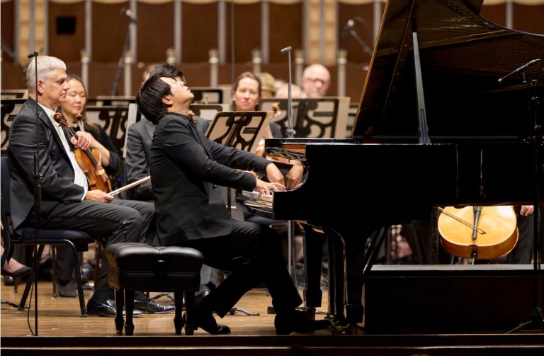By Daniel Hathaway | Cleveland Classical
This article was originally published on Cleveland.com

In general use since the mid-18th century and meaning “a person with great skill, one who is a master of the mechanical part of a fine art,” the term virtuoso only begins to describe Lang Lang. In addition to his skills on the keyboard, he’s the classical equivalent of a rock star, capable of drawing sold-out crowds to his performances, as he did in Cleveland on Thursday. And worthy of both a private audience with the Pope and — just last month — a star on the Hollywood Walk of Fame. And he’s an international advocate for the piano whose “101 Pianos” extravaganza will visit Cuyahoga Community College on Friday.
When an arm injury derailed the pianist for a year, Lang Lang was forced to re-evaluate a career that began when he was three. Cleveland Orchestra music director Franz Welser-Möst, who has known Lang Lang since the pianist was a teenager, told the New York Times in 2019, Since then he has changed as a musician. Before he would sort of go for the show-off, virtuoso stuff — he was looking in the music for the virtuosic side of a lot of these pieces. Now he has matured. A lot.
His rock star status was confirmed with thunderous applause the moment he appeared onstage Thursday evening, but the beginning of the Saint-Säens concerto revealed the pianist’s change of direction.
His relaxed approach to the long, ruminative opening solo with an elastic pulse led to an elegant statement of the movement’s main theme. Then he unleashed his signature, huge sound. His playing of the return of the opening material above soft orchestral chords was simply beautiful.
Lang Lang set up a swift tempo for the Allegro scherzando, daring Welser-Möst and the orchestra to keep up with him. Slowing for the middle section, he pounded out chords, and otherwise his dynamics ranged from soft and refined to loud and strident.
The presto allowed him the perfect opportunity to wow the audience by playing hands full of notes fast and loud which only grew louder and faster. He sometimes overwhelmed his orchestral colleagues.
Lang Lang obviously gave the crowd what they came for. They erupted in a volcanic ovation even before the final notes died away.
During numerous call-backs the pianist showed his gratitude to Welser-Möst and the Orchestra, applauding them each time he returned. Finally, he presented his admirers with a bon-bon — a sentimentally beautiful rendition of Rainbow Connection from “The Muppet Movie” that turned dramatic before vanishing into the ether.
Too bad that neither composer was present to take a bow. Saint-Saëns’ own dexterity as a pianist was embedded in the notes hereof his concerto, and Berlioz’ brilliant evocation of an opium dream in his Fantastic Symphony showed why his treatise on the art of orchestration became a famous 19th-century textbook.
Welser-Môst and the Orchestra revealed their own virtuosity in every episode of the five-movement Sinfonie, in the art of pacing, distributing climaxes, visiting every level on the dynamic spectrum from the nearly inaudible to the stentorian, and in picturesque individual and section solos. Those included the many, sneaky statements of the idée fixe, Robert Walters’ English horn solos answered by Frank Rosenwein’s off-stage oboe, the keening bassoons in the march to the gallows, and the percussion section, who
conjured up distant thunder on multiple timpani, and rang church bells and topped climaxes with resonant bass drums in the Witches’ Sabbath.
Unlike most performances where attendees applaud internally while sitting on their hands, this audience wanted to applaud after every movement. Given such a thrilling all-around display of orchestral virtuosity, who could blame them?
Photos by Roger Mastroianni.
Daniel Hathaway is the founder and editor of the online journal ClevelandClassical.com. He teaches music journalism at Oberlin College and Conservatory of Music
Published on ClevelandClassical.com May 6, 2024
Click here for a printable copy of this article




